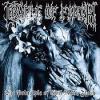I enjoy reading this today, I hope you too enjoy it.

Identifying vampires:
Many elaborate rituals were used to identify a vampire. One method of finding a vampire's grave involved leading a virgin boy through a graveyard or church grounds on a virgin stallion—the horse would supposedly baulk at the grave in question. Generally a black horse was required, though in Albania it should be white. Holes appearing in the earth over a grave were taken as a sign of vampirism.
Corpses thought to be vampires were generally described as having a healthier appearance than expected, plump and showing little or no signs of decomposition. In some cases, when suspected graves were opened, villagers even described the corpse as having fresh blood from a victim all over its face. Evidence that a vampire was active in a given locality included death of cattle, sheep, relatives or neighbours. Folkloric vampires could also make their presence felt by engaging in minor poltergeist-like activity, such as hurling stones on roofs or moving household objects, and pressing on people in their sleep.

Protection:
Apotropaics, items able to ward off revenants, are common in vampire folklore. Garlic is a common example, a branch of wild rose and hawthorn plant are said to harm vampires, and in Europe, sprinkling mustard seeds on the roof of a house was said to keep them away. Other apotropaics include sacred items, for example a crucifix, rosary, or holy water. Vampires are said to be unable to walk on consecrated ground, such as those of churches or temples, or cross running water. Although not traditionally regarded as an apotropaic, mirrors have been used to ward off vampires when placed, facing outwards, on a door (in some cultures, vampires do not have a reflection and sometimes do not cast a shadow, perhaps as a manifestation of the vampire's lack of a soul). This attribute, although not universal (the Greek vrykolakas/tympanios was capable of both reflection and shadow), was used by Bram Stoker in Dracula and has remained popular with subsequent authors and filmmakers. Some traditions also hold that a vampire cannot enter a house unless invited by the owner, although after the first invitation they can come and go as they please. Though folkloric vampires were believed to be more active at night, they were not generally considered vulnerable to sunlight.
Methods of destruction, Methods of destroying suspected vampires varied, with staking the most commonly cited method, particularly in southern Slavic cultures. Ash was the preferred wood in Russia and the Baltic states, or hawthorn in Serbia, with a record of oak in Silesia. Potential vampires were most often staked through the heart, though the mouth was targeted in Russia and northern Germany and the stomach in north-eastern Serbia. Piercing the skin of the chest was a way of "deflating" the bloated vampire; this is similar to the act of burying sharp objects, such as sickles, in with the corpse, so that they may penetrate the skin if the body bloats sufficiently while transforming into a revenant. Decapitation was the preferred method in German and western Slavic areas, with the head buried between the feet, behind the buttocks or away from the body. This act was seen as a way of hastening the departure of the soul, which in some cultures, was said to linger in the corpse. The vampire's head, body, or clothes could also be spiked and pinned to the earth to prevent rising. Gypsies drove steel or iron needles into a corpse's heart and placed bits of steel in the mouth, over the eyes, ears and between the fingers at the time of burial. They also placed hawthorn in the corpse's sock or drove a hawthorn stake through the legs. In a 16th-century burial near Venice, a brick forced into the mouth of a female corpse has been interpreted as a vampire-slaying ritual by the archaeologists who discovered it in 2006. Further measures included pouring boiling water over the grave or complete incineration of the body. In the Balkans, a vampire could also be killed by being shot or drowned, by repeating the funeral service, by sprinkling holy water on the body, or by exorcism. In Romania, garlic could be placed in the mouth, and as recently as the 19th century, the precaution of shooting a bullet through the coffin was taken. For resistant cases, the body was dismembered and the pieces burned, mixed with water, and administered to family members as a cure. In Saxon regions of Germany, a lemon was placed in the mouth of suspected vampires.
All pages by Aja
Page last updated: Apr 25 2012
NEW MEMBERS
Sycophant (6)
18:15 - December 07 2025

Curmudgeon (11)
08:32 - December 05 2025

Parasite (3)
22:58 - December 02 2025
REAL VAMPIRES LOVE VAMPIRE RAVE
Vampire Rave is a member of
Page generated in 0.0507 seconds.









COMMENTS
-
Echoe
07:02 Jan 12 2016
nice